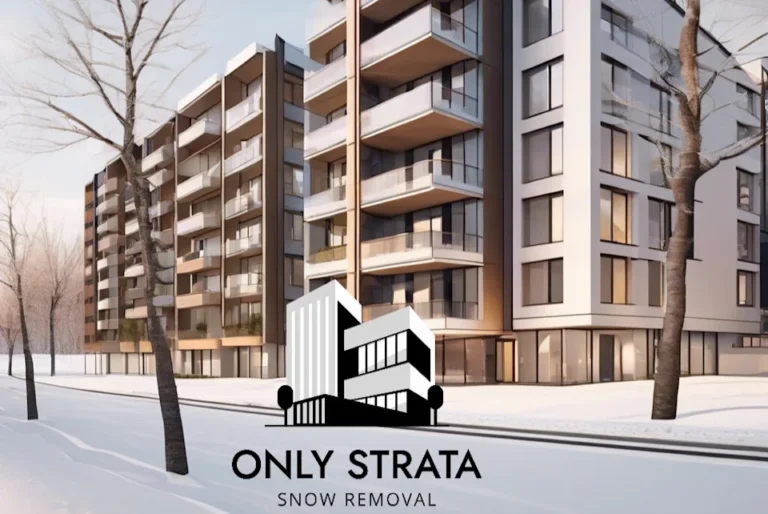Strata corporations have a clear duty to keep common areas reasonably safe in winter—sidewalks, stairs, ramps, and parking. Yet many buildings rely on vague instructions and undocumented salt use. This guide explains the responsibilities, standards, and practical steps for a defensible, people-first snow and ice program without jargon or fluff.
Why “Only Strata Snow Removal” Matters
Winter risk concentrates where people actually walk: shaded paths, slope transitions, curb cuts, loading zones, and the mid-afternoon melt/refreeze that becomes black ice by evening. Occupier-liability law in many provinces expects reasonable care a system of inspections, timely clearing, and appropriate de-icing.
Municipal bylaws typically add specific deadlines to clear adjacent sidewalks. Good winter maintenance also protects surfaces, reduces insurance claims, and controls long-term costs. In strata settings, snow removal is usually a common operating expense, so it needs a budget and a plan on paper.
What Laws, Bylaws, and Policies Expect (Plain English)
- Duty of care: Maintain a documented, reasonable system to keep common areas safe. Not perfection—proof of diligence.
- City deadlines: Most municipalities require adjacent sidewalks to be cleared by a set morning time after snowfall (e.g., 10 a.m. in larger cities).
- Common vs. limited common property: Common areas are the strata’s responsibility; bylaws generally can’t push common-property maintenance onto owners.
- Budgeting: Treat snow and ice control as a standard common expense in your operating plan.
Standards & Environmental Good Practice
Adopt recognized winter maintenance standards to anchor your RFP and service audits. Snow & Ice Management Association (SIMA) and ANSI guidance help define procurement language, documentation, and safety training. Environment and Climate Change Canada’s road-salt practices recommend covered storage, calibrated spreaders, rate control, and temperature-appropriate products—crucial for balancing safety with environmental impact. Public-sector “levels of service” (LOS) tables are great models for response times, bare-surface targets, and inspection intervals.
In-House vs. Contractor vs. Hybrid
| Option | Pros | Cons | Best For |
|---|---|---|---|
| In-House | Immediate response; full control; integrates with caretaking | Training, safety, overtime; equipment costs | Small sites with reliable on-site staff |
| Contractor | Professional gear; 24/7 callout; formal logs | Less control during citywide events; scope creep if vague | Mid-to-large sites or complex layouts |
| Hybrid | Contractor handles plowing & major de-icing; staff spot-treats | Requires clear division of duties and logging | Sites with frequent refreeze “hot spots” |
Practical Steps / Checklist (Copy-Paste for Your Board)
1) Map your winter risks
Mark shaded walks, ramps, stairs, curb cuts, drains, pavers, EV stalls, entrances, wind corridors. Assign risk tiers (high/medium/low). Photograph problem areas.
2) Write Levels of Service (LOS)
State outcomes and timelines (e.g., sidewalks and entries cleared within 6 hours after snowfall ends; driving lanes bare within 12 hours; spot checks every 4 hours during freeze warnings). Include snow-pile and haul locations.
3) Choose your delivery model
- Contractor: Use an RFP that requires proof of training, insurance, equipment lists, response times, and service logs (time, GPS, photos, material/rate, air/surface temps).
- In-house: Define equipment, PPE, training, on-call rotation, and escalation triggers.
- Hybrid: Specify who does what, when, and how it’s logged.
4) Calibrate materials and storage
Covered salt storage, spill control, rate charts by pavement temperature, and calibrated spreaders. Match product to temperature bands and consider pre-wetting or alternatives as conditions dictate.
5) Create a Winter Log
Template fields: weather (forecast + observed), air/surface temp, precipitation, start/stop times, treatment locations, material type and rate, before/after photos, and inspection notes. Keep paper copies on site and digital backups.
6) Assign sidewalk ownership
Name a responsible person or vendor to meet the municipal deadline (and a backup). Include frontage corners and accessibility ramps.
7) Communicate with residents
A one-pager in the lobby and portal: safe routes, temporary closures, how to report icy spots, pet-safe practices, and a reminder not to shovel windrows onto sidewalks.
8) Post-event debrief
Did you meet LOS? Any slips or near misses? Adjust pile locations, add drainage cuts, or consider heat-trace where refreeze persists. Capture lessons in the log.
Buyer’s Guide: Questions to Ask a Snow Contractor
- Standards & training: Which standards do you follow? Show SOPs and training records.
- Coverage & triggers: How fast do you respond during multi-site storms? What thresholds trigger pre-treating?
- Documentation: Will you provide GPS/time-stamped logs, photos, and material rate records tied to weather data?
- Materials & environment: Do you maintain a salt-management plan, covered storage, and calibrated spreaders?
- Insurance & liability: Confirm limits, endorsements, and alignment with your bylaws and duty-of-care expectations.
- Site-specific plan: Will you perform a preseason walkthrough and produce a marked site map?
You might also like: Sustainable energy in Europe: 2025 field guide for policy, business, and research
FAQ
1) Who is responsible—strata or owners?
The strata corporation is typically responsible for snow and ice on common property. Limited common property can vary by bylaw—confirm designations and language.
2) What counts as “reasonable care”?
A consistent, documented program: inspections, timely clearing, calibrated treatments, warning signage when needed, and post-event reviews.
3) Do we have to clear sidewalks if the city plows the street?
Yes. Adjacent sidewalks are generally your responsibility, often with morning deadlines after snowfall.
4) How do we reduce salt without increasing slip risk?
Use a salt-management plan: cover storage, calibrate spreaders, pre-wet when appropriate, and match products to surface temperature bands.
5) What should be in our contract?
Scope of areas, LOS timelines, call-out triggers, documentation requirements (GPS, photos, rates), insurance, and a site-specific plan map.
6) Is snow removal always a common expense?
For common property, yes—it’s part of routine operations and should be budgeted annually.
7) How often should we inspect during active storms?
Base it on risk tier and conditions; high-risk areas may need checks every 2–4 hours during freeze-thaw cycles.
Conclusion
“Only strata snow removal” means focusing on the exact people and surfaces you’re responsible for—and proving you did the right things when conditions were worst. With clear LOS targets, assigned sidewalk ownership, calibrated materials, and contractor (or in-house) logs, your corporation can demonstrate reasonable care, reduce claims, and keep residents safe. Start now: approve the budget line, publish the LOS, and put the Winter Log on a clipboard by the door.




